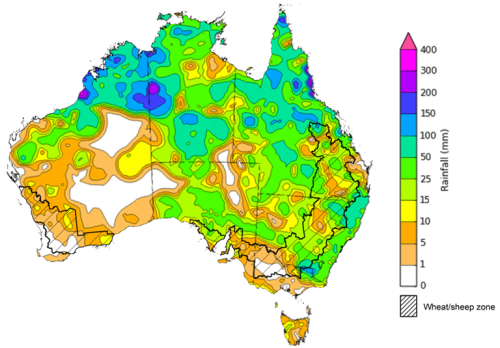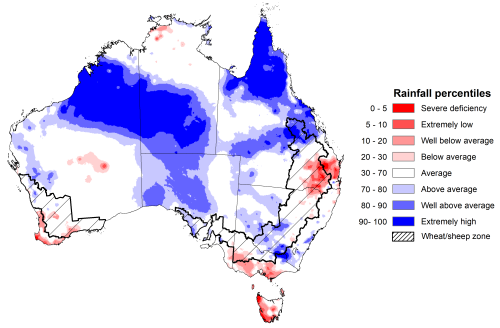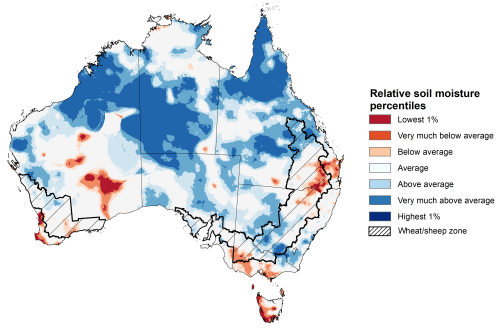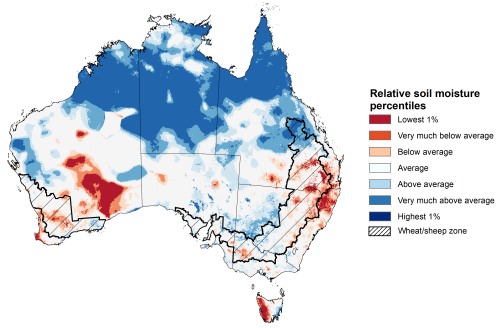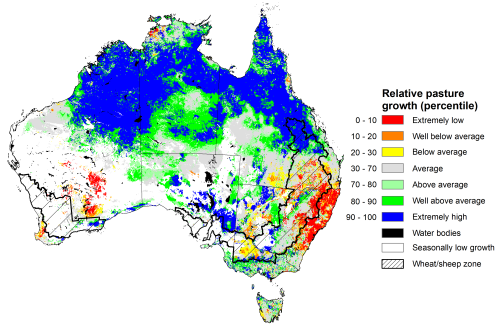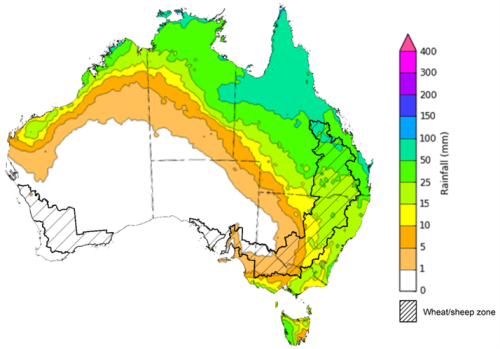Key issues
- For the week ending 1 February 2023, low-pressure systems and associated troughs remained active over most of the country and resulted in widespread rainfall and localised thunderstorm activity across northern, central and south-eastern Australia.
- Reduced rainfall across cropping regions of western Queensland have allowed floodwaters to recede, reduced the risk of waterlogging and improved the access to fields for the maintenance of summer crops. Reduced rainfall across southern Queensland likely improved field access for the harvesting of early sown summer crops to continue. Meanwhile, moderate rainfall across northern Queensland growing regions likely benefited the germination of late sown summer crops. Rainfall across New South Wales should support yield potential of summer crops as they near flowering (see Section 1.1).
- January 2023 rainfall was below average to average across most cropping regions, despite above average rainfall across cropping regions of northern Queensland and southern New South Wales. Extremely low to below average rainfall was recorded for the small parts of south-eastern Queensland. Lower rainfall totals in southern Queensland and northern New South Wales during January would have benefited the harvest of early sown summer crops. Across southern New South Wales and northern Queensland, moderate January rainfall would have provided ideal growing condition for summer crops and pastures, however, it may also have led to some disruptions in the harvest of early sown summer crops (see Section 1.2)
- Modelled pasture growth for the 3 months to January 2023, was above average to extremely high across western New South Wales, southern Victoria, northern Queensland, South Australia and northern Western Australia. This growth is likely to enable farmers to continue rebuilding stock numbers and provide opportunities to replenish fodder supplies during early summer, if conditions, such as dry warm weather suitable for fodder conservation, are to be experienced during this period (see Section 1.4).
- Over the 8-days to 9 February 2023, rainfall is expected to be restricted to northern and part of eastern Australia under the influence of low-pressure system and troughs. The moderate rainfall for summer cropping regions in Queensland and northern New South Wales is expected to build soil moisture levels and benefit the summer crops growth. However, this is likely to result in some harvest delays for early sown summer crops. The forecast rainfall over much of northern an eastern Australia is likely to build soil moisture levels in the led up to the winter cropping season and benefit pasture growth rates and availability (see Section 1.5).
- Water storage levels in the Murray-Darling Basin (MDB) decreased between 26 January 2023 and 1 February 2023 by 14 gigalitres (GL). Current volume of water held in storage is 23 421 GL which represents 93 percent of total capacity. This is 3 percent or 700 GL more than at the same time last year.
Allocation prices in the Victorian Murray below the Barmah Choke decreased from $32 per ML on 20 January 2023 to $19 per ML on 2 February 2023. Prices are lower in the Murrumbidgee and regions above the Barmah choke due to the binding of the Murrumbidgee export limit and Barmah choke trade constraint.
Climate
For the week ending 1 February 2023, low-pressure systems and associated troughs remained active over most of the country and resulted in widespread rainfall and localised thunderstorm activity across northern, central and south-eastern Australia.
Weekly rainfall totals between 25 and 400 millimetres were recorded across much of New South Wales, Queensland and the Northern Territory, large areas of South Australia, and the Kimberley and Pilbara regions in Western Australia. Rainfall totals greater than 100 millimetres were recorded over tropical north of Australia and the South-West Slopes districts of New South Wales extending over the Victorian border.
Across Australian cropping regions, rainfall totals of between 10 and 50 millimetres were recorded across some parts of Queensland, much of New South Wales, western South Australia, and some pockets of eastern Western Australia. Little to no rainfall was recorded in the remaining cropping regions.
Reduced rainfall across the cropping region of western Queensland would have allowed floodwaters to recede, reduced the risk of waterlogging and improved the access to fields for the maintenance of summer crops. Reduced rainfall across southern Queensland likely improved field access for the harvesting of early sown summer crops to continue. Meanwhile, moderate rainfall across northern Queensland growing regions likely benefited the germination of late sown summer crops. Rainfall across New South Wales would support yield potential of summer crops as they near flowering.
Rainfall for the week ending 1 February 2023
Issued: 01/02/2023. Note: The rainfall analyses and associated maps utilise data contained in the Bureau of Meteorology climate database, the Australian Data Archive for Meteorology (ADAM). The analyses are initially produced automatically from real-time data with limited quality control. They are intended to provide a general overview of rainfall across Australia as quickly as possible after the observations are received. For further information go to http://www.bom.gov.au/climate/rainfall/
Rainfall during January 2023 was above average to extremely high for central and southern parts of the Northern Territory, northern, central and south-eastern Queensland, much of South Australia, northern rangelands and Gascoyne and Murchison regions in Western Australia, and parts of north-western and southern New South Wales. In contrast, rainfall was extremely low to below average for parts of south-eastern Queensland and much of southern Victoria.
The active La Niña event on the Pacific remained the main climate influence during the January. Extremely high rainfall total across the north of Australia were associated with the movement of low-pressure systems and troughs and break down of ex-tropical cyclones Ellie. January 2023 rainfall was below average to average across most cropping regions, despite above average rainfall across cropping regions of northern Queensland and southern New South Wales. Extremely low to below average rainfall was recorded for the small parts of south-eastern Queensland.
Lower rainfall totals in southern Queensland and northern New South Wales during January should have benefited the harvest of early sown summer crops. Across southern New South Wales and northern Queensland, moderate January rainfall would have provided ideal growing condition for summer crops and pastures, however, it may also have led to some disruptions in the harvest of early sown summer crops.
Rainfall percentiles for January 2023
Modelled upper layer soil moisture for January 2023 was generally average or higher than average for this time of year across most of Australia, reflecting the high rainfall through the month. However, it had significantly geographic differences between the north and south of Australia, reflecting the spatial pattern of rainfall during January 2023. Extremely low upper soil moisture was modelled for some parts of south-eastern Queensland, the north-eastern New South Wales and southern Victoria, inland south and south-eastern seaboard in Western Australia, as well as western Tasmania. Extremely high upper layer moisture was evident across far north and central Queensland, the central and southern areas of the Northern Territory, Kimberly and Pilbara regions in Western Australia, and alpines region of south-eastern Australia.
At this time of year, upper layer soil moisture is important for late planted summer crops in northern New South Wales and Queensland and for pasture growth across northern Australia since plant germination and establishment utilise this moisture. It is also an important indicator of the ability to access paddocks for crop harvesting and planting activities.
Upper layer soil moisture was below average to average for this time of year across most of cropping regions with above average to very much above average dominated in the northern Queensland, south half of New South Wales and northern Western Australia. Extremely low levels of upper layer soil moisture were present for some parts of south-eastern Queensland and south-western tips of Western Australia. Low levels of upper layer soil moisture would have allowed paddock access to harvest early planted summer crops for northern cropping regions while moderate soil moisture in northern Queensland would have benefited the growth of pasture and some summer crops.
Modelled upper layer soil moisture for January 2023
Source: Bureau of Meteorology (Australian Water Resources Assessment Landscape model)
Lower layer soil moisture for January 2023 was well above average to extremely high for this time of year across northern and central Queensland, much of the Northern Territory, the Kimberley , Gascoyne and Murchison regions in Western Australia. Lower layer of soil moisture was below average to extremely low in parts of southern Queensland, north-eastern New South Wales, southern Western Australia, and western Tasmania.
Lower layer soil moisture is important to support summer crops and pasture growth during the peak growth period. In Australian cropping regions, lower layer soil moisture was average to above average across northern Queensland and south-western New South Wales, South Australia, as well as scattered areas of Victoria and south-eastern Western Australia. Lower layer soil moisture was below average to average across large cropping areas of southern Queensland, eastern New South Wales, south-western Victoria and south-western Western Australia. High levels of lower layer soil moisture will continue to support above average yield prospects for summer crops and above average pasture growth for this time of year.
Modelled lower layer soil moisture for January 2023
Source: Bureau of Meteorology (Australian Water Resources Assessment Landscape model)
Pasture growth during the November to January period is the peak pasture growth period for northern Australia which typically provides a bulk of feed to maintain production through the low pasture growth months of the northern dry season. Across southern Australia, November to January pasture growth is typically low reflecting lower rainfall totals, high temperature and high evapotranspiration rates at this time of year. Pasture availability during this period influences the growth and branding and marking rates of lambs and calves, livestock turnoff and the production of meat, milk, and wool.
For the 3 months to January 2023, above average rainfall totals and mild temperatures resulted in well above average pasture production for this time of year across most grazing regions primarily in the northern and central Australia.
Modelled pasture growth was above average to extremely high across western New South Wales, southern Victoria, northern Queensland, South Australia and northern Western Australia. This growth will likely enable farmers to continue rebuilding stock numbers and provide opportunities to replenish fodder supplies during late spring or early summer, if conditions, such as dry warm weather suitable for fodder conservation, were experienced during this period. In contrast, modelled pasture growth was extremely low to below average across scattered areas in the wheat/sheep zone, central and eastern New South Wales, south-eastern Queensland, north-eastern Victoria, and southern parts of Western Australia. In some regions, this low pasture growth likely reflects a decline in plant growth due to excess moisture.
Relative pasture growth for 3-months ending January 2023 (1 November to 31 January 2023)
Source: Queensland Department of Science, Information Technology and Innovation.
Over the 8-days to 9 February 2023, rainfall is expected to be restricted to northern and part of eastern Australia under the influence of low-pressure system and troughs. A monsoon trough is expected to bring increased rainfall across northern Australia, while onshore winds are expected to bring mostly dry conditions to much of eastern Australia. An approaching cold front is expected to bring showers to large areas of south-eastern Australia in the late of next week.
Rainfall totals exceeding 15 millimetres are expected across northern and central-eastern parts of the Northern Territory, much of Queensland and eastern New South Wales, southern Victoria and the Kimberley region and north-west in Western Australia, as well as western Tasmania. Rainfall totals in excess of 50 millimetres are expected for the north and eastern seaboard of Queensland and adjacent area of the Northern Territory, as well as some pockets of north-western of Kimberly region and Darwin region. Little to no rainfall is forecast for the remaining area of Australia for the next eight days.
Across Australian cropping regions, rainfall totals of between 10 and 50 millimetres are expected for most of the Queensland and northern New South Wales. Rainfall totals of between 50 and 100 millimetres are expected for the far northern Queensland cropping regions. Little to no rainfall is expected for the remaining cropping regions in the next eight days.
The moderate rainfall for summer cropping regions in Queensland and northern New South Wales is expected to build soil moisture levels and benefit the summer crops growth. However, this is likely to result in some harvest delays for early sown summer crops. The forecast rainfall over much of northern and eastern Australia is likely to build soil moisture levels in the led up to the winter cropping season and benefit pasture growth rates and availability
Total forecast rainfall for the period 2 February to 9 February 2023
Issued 02/02/2023.
Water
Water storages, water markets and water allocations - current week
The Tableau dashboard may not meet accessibility requirements. For information about the contents of these dashboards contact ABARES.
Commodities
Information on weekly price changes in agricultural commodities is now available at the Weekly commodity price update.

